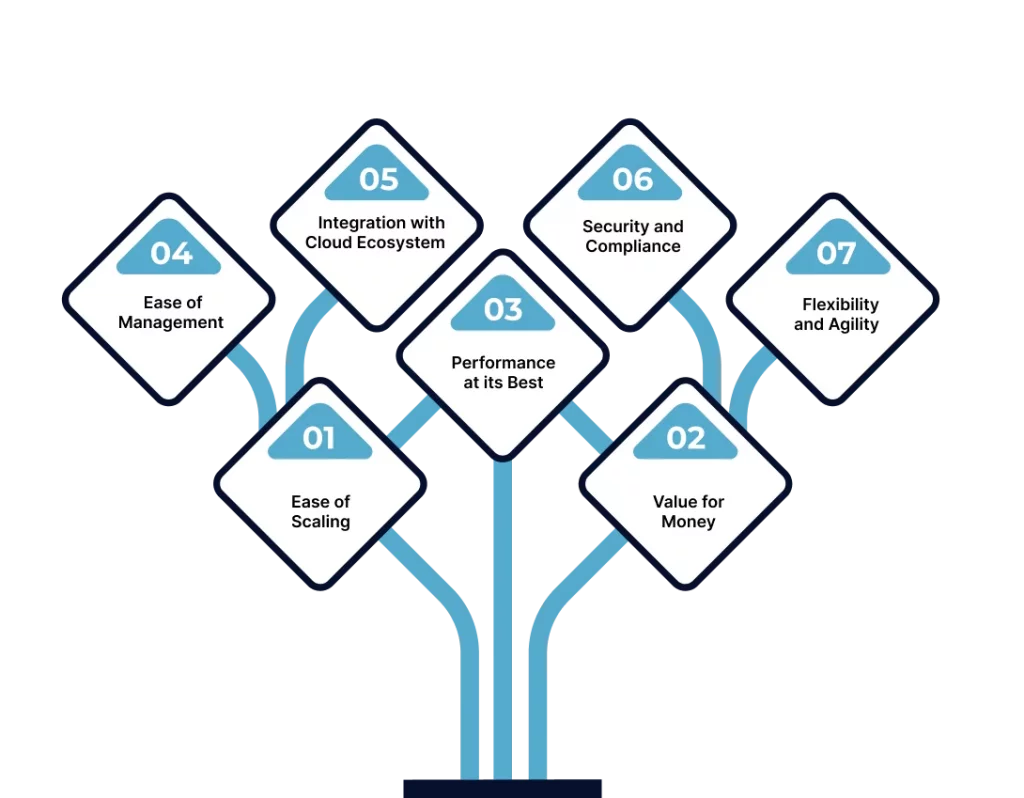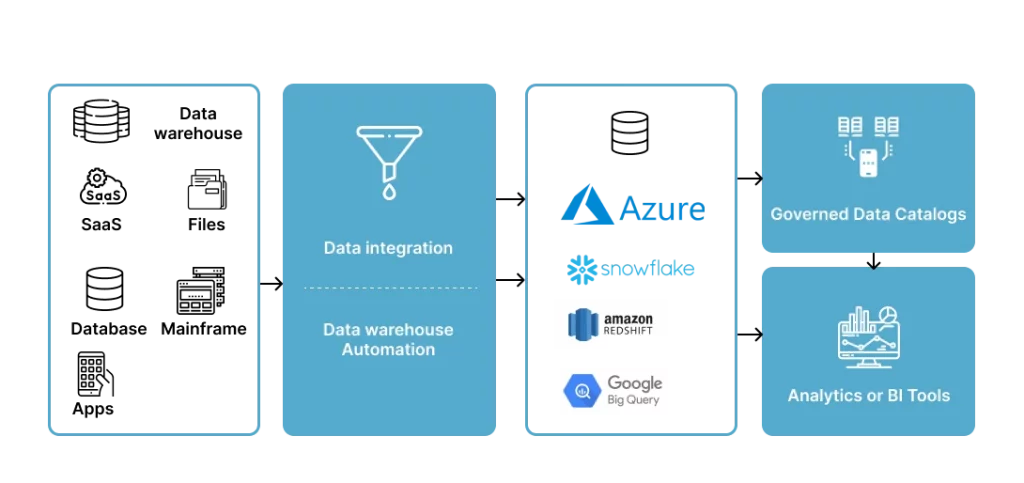Most business-critical data is now stored in the cloud. Data warehouses are thus needed to store data from all cloud-based applications seamlessly. This is where the Cloud Data Warehouse comes into play.
Cloud data warehouses are modern methods of storing and managing large amounts of data. Data can be accessed and used quickly from anywhere. They help teams use advanced analytics to gain critical insights, improving operations, customer service, and overall business processes. Organizations and data-driven companies need robust solutions for managing and analyzing large quantities of data.
In 2026, the cloud data warehousing industry is expected to reach $12.9 billion, growing at a compound annual rate of 22.3%. Despite North America and Europe having the largest market share, Asia-Pacific has the fastest-growing cloud data warehousing segment, driven by China and India’s booming megamarkets.
The cloud-based data warehouse is becoming increasingly important and popular in the industry, so let’s look at what it is, how it works, its benefits, the best cloud providers, and the difference between on-premises and cloud data warehouses.
What is a Cloud Data Warehouse?
Cloud Data Warehouses are online repositories where an organization aggregates data from various sources like the Internet of Things, relational databases, and data systems. The data can also be accessed and analyzed for the purposes of running a business. Basically, it is delivered as a managed service in the public cloud and designed to be highly scalable, easy to use, and analytics-friendly.
The data warehouse is the core of an organization’s business intelligence infrastructure. A Relational Database Management System (RDBMS) allows users to run SQL-like queries on information stored in it.
Data warehouses are optimized to handle large data sets with analytical queries. The most common use of a database is as a transaction processing system. You can read more about enterprise data warehouses here.
One of the most important benefits of cloud-based data warehouses is that they enable businesses to concentrate on running their businesses rather than managing a server room. Also, they improve access, scalability, and performance to enable business intelligence teams to deliver faster and better insights.
Key Features of Cloud Data Warehouse
There are certain features inherent to cloud data warehouses that make them valuable to businesses. Among them are:

- Centralized Data Storage
With a cloud data warehouse, all your data will be in one place, eliminating scattered information silos.
- Automated Workflows
A cloud data warehouse eliminates many repetitive tasks by automating workflows like data extraction, transformation, and loading (ETL).
- Enhanced Scalability and Elasticity
You can easily scale storage and processing power up or down based on your changing data volumes and analysis needs.
- Data Security
Another important feature is security. Its robust access controls, encryption, and data governance policies protect your organization’s sensitive information.
- Data Integration and Management
By automating processes, data integration from diverse sources becomes seamless.
- Data Transformation and Cleaning
You can analyze raw data by cleaning and transforming it into a consistent format.
- Self-Service BI
With user-friendly BI tools and dashboards, business users can explore and analyze data independently.
- Getting Insights Faster
It helps you make more informed decisions by streamlining the process of accessing and analyzing data.
Traditional Data Warehouse vs Cloud Data Warehouse
In the traditional sense, a Data Warehouse is a localized or domestic system installed on the organization’s premises. Companies must purchase their own hardware, such as servers, etc., requiring human resources and time. In addition, the organization will have to hire new staff and buy, ship, and install all new hardware in order to manage this traditional data warehouse.
On-premises data warehouses don’t scale well and aren’t designed to handle raw, unstructured, or complex data. Traditional data warehouses aren’t designed to handle the growing number of users, data volume, processing workloads, and data analysis use cases of today.
As its name implies, Cloud Based Data Warehouse is a data warehouse that is hosted in the cloud. Organizations or companies do not have to worry about maintaining their own hardware.
Third-party Cloud Data Warehouse service providers handle the scaling, maintenance, and hardware updates. Google, Snowflake, and others are some of the most common cloud data warehouse providers.
Cloud data warehouses are the flexible apartments of the data world. A pay-as-you-go model allows them to be scalable and accessible from anywhere, freeing up your IT resources. Security is strong, but it might not be ideal for ultra-sensitive data.
If you want to align your functional and non-functional requirements and drive maximum productivity, you can also opt for cloud application development services. This will ensure that you get the most out of cloud features.
The choice between these two depends on the needs of your organization. You might favor the cloud for its affordability, scalability, and ease of access, whereas a traditional warehouse might be a good choice for highly sensitive data or strict security controls.
Bonus Read: 5 Ways Small Businesses Can Benefit From Cloud Computing
How Data Warehousing Works in the Cloud?
Cloud data warehouses usually work the same way as traditional ones. A data warehouse collects, integrates, and stores data from internal and external sources. A data pipeline is usually used to transfer data from a source system. It involves obtaining data from the source system, transforming it, and then loading it into the data warehouse. It’s also possible to send data directly to a central repository and then convert it using ELT (extract, load, transform).

Business intelligence (BI) tools can then be used to analyze, mine, and report on the data. A cloud data warehouse should also support streaming use cases to activate data in real-time or near-real time.
Cloud data warehouses provide structured and semi-structured data storage, processing, integration, cleansing, loading, and so on. Unstructured data can also be collected and stored in a cloud data lake. Depending on your provider, you can centrally manage your enterprise data by unifying your data warehouse and data lake.
Depending on the cloud provider, cloud based data warehouse services may take a different approach. Sometimes, some cloud data warehouses use cluster-based architectures similar to traditional ones.
On the other hand, others adopt serverless architectures, which minimize data management tasks. AWS, Google Cloud, and Azure are top serverless cloud providers. Most cloud data warehouses offer data storage and capacity management features and automatic upgrades.
What are the Benefits of Cloud Data Warehouse for Organizations?
IT departments are looking for a silver bullet to help them meet the growing demands for data access. The silver bullet would be the cloud. A cloud data warehouse offers many benefits, including:

1. Ease of Scaling
There is a constant change in company needs. Companies can easily scale their storage and compute resources with Cloud Data Warehouses, depending on their needs.
It provides virtually unlimited scalability, allowing organizations to increase or decrease storage and compute resources easily. Businesses can take advantage of this elasticity without investing in additional infrastructure to handle fluctuations in data volume and query workload.
2. Value for Money
Companies no longer need to invest in hardware and infrastructure for data storage. When you opt for a Cloud Data Warehouse, you have an option to pay for the storage and compute resources it consumes in a pay-as-you-go cloud data warehouse.
It is, therefore, a cost-effective solution for businesses of all sizes. A cloud provider may also offer reserved instances or on-demand pricing, allowing users to optimize costs based on their usage patterns.
3. Performance at its Best
With a cloud based data warehouse, you can process complex queries on large datasets in a fraction of the time, enabling faster insight and decision-making.
Furthermore, data from every department of an organization can be accessed simultaneously without affecting performance. Multiple servers sharing the load allow large amounts of data to be processed simultaneously without any delays.
4. Ease of Management
Another benefit of a Cloud Data Warehouse is that you don’t have to worry about infrastructure management using cloud data warehouses. As a result, cloud data warehouses are easy to manage since they require no hardware provisioning, software installation, configuration, or maintenance.
Cloud providers handle these tasks, so organizations can concentrate on data analysis and insight extraction rather than managing infrastructure.
5. Integration with Cloud Ecosystem
Data warehouses on the cloud integrate seamlessly with other cloud services, such as data lakes, machine learning platforms, BI tools, and ETL tools. By integrating these systems, organizations can simplify data pipelines, improve collaboration, and create a comprehensive analytics ecosystem.
6. Security and Compliance
A cloud data warehouse offers robust security features for securing data at rest and in transit. Vendors of cloud data warehouses provide encryption, access controls, audit logging, and compliance certifications to ensure data security.
Cloud providers also invest heavily in security, including network security, physical security, and data protection, so your data’s safe.
7. Flexibility and Agility
Since market conditions and business requirements are constantly changing, businesses need cloud data warehouses to quickly adapt to changing business needs.
The agile development methodology allows the team to iterate quickly on data models and analytics. The flexibility of cloud data warehouses also allows users to utilize diverse datasets and analytical workloads for insights.
Cloud data warehouse and cloud computing are concepts that are often used together to support modern data management and analytics. Here you can read about the benefits of cloud computing.
Top Cloud Data Warehouse Vendors
With a modern cloud architecture, you get the power of data warehousing, the flexibility of Big Data platforms, and the elasticity of the cloud at a fraction of the cost of traditional solutions. The following are the top 7 vendors that offer cloud data warehouse services.
- Amazon Redshift
- Azure Synapse Analytics
- Google BigQuery
- Snowflake
- Oracle Autonomous Data Warehouse
Here’s a closer look at each.
1. Amazon Redshift
Best for: Big data warehouse, deployment options
Redshift is an Amazon cloud based data warehouse that scales from a few hundred gigabytes to petabytes. With the solution, you can upload any data set and analyze it. No matter what the size of the data set is, Redshift provides fast query performance. Depending on the user’s skill level, there are multiple ways to manage clusters on AWS.
Pros
- Ability to process data in parallel
- Provides network isolation security
- Good documentation
Cons
- Expensive
- A poor user interface
- Duplicate records cannot be restricted
2. Azure Synapse Analytics
Best for: Midsize data warehouse, for code-free offering
Synapse is a Microsoft analytics service that helps you integrate data, implement enterprise data warehouses, and analyze big data. Users can query data either using serverless resources or dedicated resources.
Besides providing an integrated business intelligence and machine learning experience, it also offers a seamless ingest, exploration, preparation, management, and service experience. Furthermore, Synapse has advanced security and privacy features, like column- and row-level security.
Pros
- Easy integration
- Some code-free offerings
- Strong data distribution
Cons
- Difficult logging metrics
- Limited documentation
- Insufficient diagramming tools
3. Google BigQuery
Best for: Efficient storage of large amounts of data with infrequent queries, serverless technologies
The BigQuery data warehouse is a fully managed, serverless solution by Google that automatically scales to match your storage and processing needs. Because Google does not expect you to manage your data warehouse infrastructure, BigQuery hides many details about your warehouse’s hardware, database, nodes, and configuration.
With its elasticity, you can start using it right away. Getting started is as simple as creating an account with Google Cloud Platform (GCP), loading a table, and running a query. Google handles the rest.
Pros
- Works with Google Cloud
- Full SQL query support
- Efficient management of data
Cons
- Lack of user support
- Beginners may find data warehouses difficult
- Difficult user interface
4. Snowflake
Best for: Cloud agnostic data warehouse, Midsized companies
Snowflake is an MPP-based cloud data warehouse that runs on AWS, Azure, and GCP. Snowflake is the only data warehouse not hosted on its own cloud, unlike the others listed here. Snowflake’s code base is interchangeable, so you can move your data from one cloud to another without recoding or learning new skills.
With Snowflake, you can perform advanced transformations, run queries quickly, enhance security, and scale your data warehouse automatically according to warehouse demands.
Pros
- Integration with AWS, Azure, and GCP
- SQL-based queries for analytics
- Support for JSON and XML
Cons
- Limited data visualization
- Dynamic SQL cannot be created
- Complicated documentation
5. Oracle Autonomous Data Warehouse
Best for: Existing Oracle database users
Oracle Autonomous Data Warehouse is a cloud-based data warehouse that helps businesses protect data and build data-driven applications. Additionally, it automates provisioning, scaling, tuning, backing up, and configuring the data warehouse.
Additionally, Oracle offers a wide range of data loading capabilities, including self-service data loading, data transformations, business models, automatic insights, and built-in database capabilities. This allows a wide range of data types to be queried, and machine learning can be applied.
Pros
- Support for migrations to other databases
- Purpose-built hardware
- Fast query performance
Cons
- No on-premises solutions
- Data connection limitations
- Complicated setup

Cloud Data Warehouse Providers: What To Look For?
Several criteria must be considered when choosing a cloud data warehouse service.
Identify the Needs of the Organization
Evaluate factors like data volume, performance requirements, scalability, and security considerations. They should meet the needs of your organization.
Evaluate Features
The major public cloud providers each have their own data warehouse that integrates existing resources, making deployment and use easier. Make sure you compare deployment options, integration options, and compliance support.
Ability to Migrate Data
Consider the organization’s different types of data and how it is stored. Cloud migration must be effective for a new data warehouse.
Review Pricing Models
Pricing plays an important role for many organizations. Compare the prices of all cloud data warehouse providers to make sure they’re aligned with your budget. There are also many providers that offer free trials as well.
Check the Reliability
Customer support is just as important as features. Check if the provider offers uptime guarantees, customer support quality, and vendor reputation.
Plan for Growth
As your organization grows, you should select a provider that can scale along with it and support emerging technologies.
Conduct a Thorough Assessment
You should consider your company’s unique requirements when determining which data warehouse provider would be the best fit for you.
Snowflake, for example, is perfect for those who work with JSON in their data warehouse. Businesses should not choose Redshift without a dedicated data administrator, as it requires configuration and regular monitoring.
if you’re still not sure how to move forward, choose cloud management services to effortlessly migrate your data to the cloud.
What is Cloud Data Warehouse Automation?

A cloud data warehouse automates the manual process of building and managing a data warehouse. A pre-built data lifecycle workflow automates data extraction from various sources and loads it into the warehouse. As a result, ETL (Extract, Transform, Load) processes are no longer required to be coded in complex, time-consuming ways.
Cloud data warehouse automation helps you ensure high-quality data for analysis by automating data cleansing and validation steps. Everything from scheduling jobs to monitoring performance is automated, making management even easier.
Automation of cloud data warehouses offers significant benefits. It reduces costs by minimizing manual labor and infrastructure requirements. Users get valuable insights quicker with faster deployments.
The automatic scaling of datasets ensures smooth performance despite large datasets. Businesses can make better decisions based on their data by automating cloud data warehouses with the help of cloud data warehouse consulting firms.
Wrapping Up Thoughts on Cloud Data Warehouse
Most businesses would benefit from a cloud data warehouse compared to an on-premise warehouse. Cloud warehouses are easier to set up and more affordable than traditional warehouse systems due to their storage and scalability limitations.
Cloud based data warehouses not only streamline data management but also automate and organize data efficiently to deliver actionable insights. This leads to more strategic and informed decisions across all levels of the organization. Organizers can maximize their data’s potential with a centralized and secure platform that allows them to manage massive datasets.
Today, organizations prefer cloud service providers that use serverless infrastructure because they are scalable, cost-effective, and fully managed. You should choose a cloud data warehouse provider considering many factors, including your architecture, your use cases, the price, and the ease of migration. If you want to succeed, you must transform your data from a static collection into a dynamic wellspring of insights.









